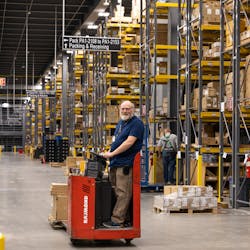The shortage of components that machine builders have been experiencing for the past few years still lingers. Guesses as to when supplies will return to normal are far-ranging, but distributors and integrators alike have done their best to meet demand and offer alternatives when components are on back order.
“Most of our supply problems have greatly improved with a few exceptions,” says Josh Robles, category manager at RS. Variable-frequency drives continue to have long lead times due to component shortages, “but our manufacturer partners are working every day to alleviate the situation,” he assures.
“There has not been a lot of improvement,” warns Mike Drew, engineering manager at Sterling Systems and Controls in Sterling, Illinois. “It is still very hit-and-miss on finding components available in a timeframe that end users are looking for. It is very common for a systems integrator to build estimates and proposals to end users based on components available at the time but then still have difficulty after the sale since automation-component availability changes so rapidly and the components that are planned to be used are unavailable or available with very long extended lead time, and the system has to be re-engineered with available components.”
Jeff Sanders, B.S.M.E., system integration manager at George T. Hall, headquartered in Anaheim, California, and a certified member of the Control System Integrators Association (CSIA), isn’t sure things have improved a whole lot. “We are still needing to be dynamic with regard to product selection during the engineering and purchasing processes, which often do not line up due to project-timeline requirements,” he says.
“Customers and integrators are still saying that the popular platforms are taking six months or more to receive,” says Tobey Strauch, an independent principal industrial controls engineer based in Fremont, California, who notes that she’s experienced difficulty finding certain safety controllers right now. “This has pushed people to choose other system components that are more readily available,” she admits. Also, some robot manufacturers promise to deliver within four weeks, while others may take up to three months.
“Stocked parts that were on the shelf, for whatever reason, are being bought at cost because of availability,” she notes. “You may get a robot that fits your needs but is missing a TwinCAT card interface.” This may require a field-install after the robot is purchased and delivered.
Other suppliers may have robots on the shelf and sell directly to the end user, who then has more availability but less support, or different support, notes Strauch. “These things must be considered in the integration costs,” she explains. “I may be able to build something more quickly with Allen-Bradley and the premade blocks that come with the Rockwell Automation solutions. If I am using a different platform, I may have to build the interface for the EtherNet/IP connections, due to not having the add-on instructions or built-in structures already in the library of the RSLogix software. This equates to time.”
People planning projects are failing to understand these differences now, says Strauch. “We are trying to find a balance of customer delivery and engineering costs,” she explains, noting how engineering costs go up when integrators change platforms from what they are familiar with or already have predefined code with.
“We haven’t had to order many parts for our plant over the past couple of years, not for new installs or projects anyway,” explains Mark Lee, CHP technical manager at Prinovis, a print service provider in Liverpool, which plans to cease operations in the summer of 2023. “When a part has failed, we often have suitable spares to not make a big impact, and, at some point, the spare has been replaced with a new part on the store’s shelves.”
Due to weaker consumer, commercial market prediction, lots of industrial-controls shortage issues are eased, explains Joseph Yang, director of product management at Advantech, a Taiwanese company with U.S. offices in California, Illinois, Ohio and Massachusetts. “The availability of components and devices has improved significantly. Although not 100% yet, we have seen a 70-80% improvement,” he notes.
"While supply chains are still stressed, there does seem to be signs that the pressures will be easing," agrees Sam Hoff, chief executive officer at Patti Engineering, a CSIA-certified member with its corporate office in Auburn Hills, Michigan.
The situation has improved quite a bit in the past few months, agrees Jason Andersen, vice president, strategy and business line management, Stratus Technologies in Maynard, Massachusetts. “But we are nowhere near out of the woods yet,” he warns. “We are still seeing shortages pop up at times, and we are also still dealing with long lead times and increased costs. Also, there is the big question of how supply chain teams can become more resilient in the future to prevent future problems.”
The availability of components and devices hasn’t improved, says Heath Stephens, PE, digitalization leader at Hargrove Controls & Automation, a certified member of CSIA in Mobile, Alabama “This is especially true for any equipment or equipment components manufactured in China,” he explains. “Currently, we are seeing PLC hardware lead times of six to 15 months for equipment that had 90-day lead times pre-pandemic. The recent relaxing of China’s Zero COVID policy may change this picture in the future but likely will result in an even worse situation in the near term.”
Availability of components has continued to worsen, agrees Judson Perkins, panel fabrication design, Hargrove Controls & Automation. “Not only are lead times long, but most manufacturers cannot provide accurate delivery dates,” he says.
While there has been an improvement in the delivery of many of the components, there are still many components with delivery not until the second half of 2023, adds Daniel Weiss, product segment lead—industrial, Newark, an Avnet company based in Chicago.
“Like most individual suppliers, Airline has been in a similar boat, but our competitive advantage is the diversity and lack of concentration on our line card,” says Mark Steffens, CEO of Airline Hydraulics, headquartered in Bensalem, Pennsylvania. “For example, we have numerous HMI, PLC and motion-control suppliers. As a result, we have the great fortune of getting the customers the functional product they need to meet their objectives. We also have direct links to most of the supplier’s inventory and due-in stock displayed on our website for internal and external customer use. All of this has made us well-equipped to help customers through supply-chain disruptions.”
The supply chain has recovered greatly since the peak of the pandemic and the chip shortage, notes Freeman Smith, founder of Nufactur, a distributor clearinghouse based in Naperville, Illinois. “However, component procurement seems to be permanently scarred by the last few years,” he warns. “It feels like shipping dates are more frequently shipping estimates rather than set-in-stone delivery dates. Also, prices move much more rapidly than they have in a long time,” he says.
“The availability of components and devices is still a serious problem for automation,” explains James Potisk, application engineer at Automation24, who believes it’s an ongoing issue that has yet to be resolved.
“There has been a slight easing of the supply-chain disruptions for electronic components and semiconductors,” notes Allison Sabia, president and CEO of Galco Industrial Electronics, headquartered in Madison Heights, Michigan. “However, lead times remain longer than those prior to the pandemic with certain products unavailable for purchase due to continued uncertainty.”
About the Author
Mike Bacidore
Editor in Chief
Mike Bacidore is chief editor of Control Design and has been an integral part of the Endeavor Business Media editorial team since 2007. Previously, he was editorial director at Hughes Communications and a portfolio manager of the human resources and labor law areas at Wolters Kluwer. Bacidore holds a BA from the University of Illinois and an MBA from Lake Forest Graduate School of Management. He is an award-winning columnist, earning multiple regional and national awards from the American Society of Business Publication Editors. He may be reached at [email protected]

Leaders relevant to this article:


